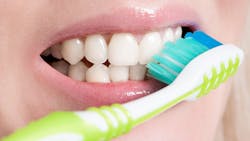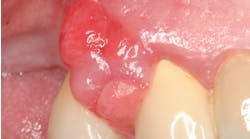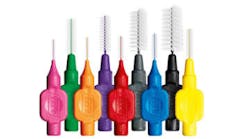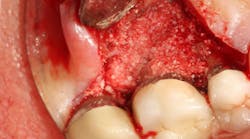Editor's note: Originally published in 2019. Reviewed in 2023.
Bacteria in dental plaque are causative agents in the initiation of dental caries, gingivitis, periodontitis, and peri-implant diseases, along with an individual’s response to these bacteria.1 A major responsibility of the dental professional in the prevention and treatment of caries and periodontal disease is to motivate patients into taking responsibility for their dental health through oral hygiene.2 Despite best efforts by dentists and dental hygienists, patient levels of home care can vary considerably and are often suboptimal.
American Dental Association recommendations for oral hygiene:3
- Toothbrushing for at least two minutes with a fluoride-containing toothpaste twice a day
- Daily interproximal cleaning (cleaning between the teeth)
- Having a well-balanced diet with limited snacking
- Regular professional cleanings and exams with a dentist
Despite these recommendations, the average person brushes for only 45 to 70 seconds once a day.4 Most studies suggest that compliance is consistent with the rule of thirds: one-third of patients will be very compliant, one-third will be moderately compliant, and one-third will be noncompliant.5 However, when it comes to patient compliance with regular interdental cleaning and flossing, it has been estimated that compliance is as low as 2%.6 In fact, when asked in a survey about flossing, 32% of the participants stated that they would rather clean their toilet or wash dishes than floss.7
You may also be interested in ...
Halitosis: Etiology, diagnosis and treatment
What is the best way to convey the importance of oral hygiene to dental patients? Many practitioners in the dental health allied field use analogies. Analogies provide an effective way of communicating, especially when trying to explain new or hard-to-understand concepts to others, because they help us to bridge the gap simplistically.8
Analogies dental pros use to inform patients about the importance of oral hygiene:
No. 1: If you brushed your hair and had blood on the hairbrush, would you think that was normal? So why would blood on your toothbrush be normal? Bleeding anywhere is a sign of a problem. — Greg Kurtzman, DDS
No. 2: Gum disease is like an infection the size of your fist. Imagine if that were on your arm or leg, and it bled every time you touched it; would you go to the doctor to get it fixed? — Addison Killeen, DDS
No. 3: Why do you need to brush and floss? Have you ever taken your filthy, dirty car to the car wash that only sprays water? It still comes out kinda grey and not totally clean. If you take it to the one that has water and the mechanical action of brushes, the car comes out much cleaner. It’s the same with teeth. — Audra Ward, DMD
No. 4: When describing pockets during probing, I tell the patient that it’s like a pool table ... the deeper the pocket, the more pool balls can fit. Just like the deeper the space of the pocket in the gums (I say gums to them), the more bacteria can get in there and cause a problem. — Kerri Rossiello, RDH
No. 5: I take the plaque on the perio probe and ask, "If I put this on a cracker, would you eat this?" I always hear, “Gross, no, ugh, and yeew.” Then I say, "Well, if you're not brushing and flossing, every time you eat anything, you're eating this." Pause. "So, makes sense to brush and floss, right?” — Martin C. Courtney, DDS
No. 6: We clean our office every night, which is like your regular cleanings, but twice a year we have the cleaning people in to do a more thorough cleaning, like spring cleaning; they clean into the corners and the duct work, etc. Root planing (deep cleaning) is like spring cleaning. We get deeper under the gum tissue and thoroughly clean the root surfaces. This can’t be done at your regular visits. — Maxine Feinberg, DDS
No. 7: Say you cooked a great spaghetti dinner and sauce gets on the top of the stove and the wall behind the stove. After you are done, you clean the stove and countertops until they are spick-and-span. Now, pull the stove away from the wall and it will be dirty. Brushing is like cleaning the top of the stove and countertops; flossing is like pulling the stove away from the wall and cleaning behind it. — Sandy Swanson Nyquist, RDH
No. 8: When patients complain about how their teeth bleed when they floss, I say, “If you walked a mile barefoot today, would your feet bleed?” They usually say, “Yes.” I then ask, “If you walked that same mile barefoot every day for a month, would they still bleed?” Then they all say, “No, probably not.” I tell them it’s the same with their mouth and flossing. — Nina Carresi, RDH
No. 9: Think of deep pockets like the deep end of a swimming pool. You can take a skimmer and clean the top surface of the pool (floss), but you need a pool cleaner (dental professional) to get the grit/rocks (calculus) out from the deep end. At that point, you just need to maintain it! Think of antibiotic therapy as the chlorine, if needed. — Holly Gamal-Caccia, RDH
No. 10: "How're you doing with brushing and flossing?" We ask, "How is your flossing going?" They will sometimes say, "Oh, I brush after every meal now," and I tell them that's great, but that's not where your disease is. I tell them the old kids’ camp skit where a guy is standing under a streetlamp looking around for something on the ground. Successive people walking by and ask him what he's doing. "I'm looking for my quarter I dropped." So, each successive passerby stops to help, and there are four to five people looking for the quarter under the streetlamp. Then someone asks, "Where did you lose it?" He says, “Over there” (and he points about 15 feet away in the dark). "Well, then why are you looking here?" And he says, "It's easier to see under the streetlight." I tell them the brushing is OK, and it's easier to do that, but it's not going to cure your disease because it's almost entirely between your teeth. — Geoff Bauman, DMD
Editor’s note: This article originally appeared in Perio-Implant Advisory, a chairside resource for dentists and hygienists that focuses on periodontal- and implant-related issues. Read more articles and subscribe to the newsletter.
References
- Hong BY, Araujo MVF, Strausbaugh LD, Terzi E, Ioannidou E, Diaz PI. Microbiome profiles in periodontitis in relation to host and disease characteristics. PLoS One. 2015;10(5):e0127077. doi:10.1371/journal.pone.0127077
- Lindhe J, Westfelt E, Nyman S, Socransky SS, Haffajee AD. Long-term effect of surgical/non-surgical treatment of periodontal disease. J Clin Periodontol. 1984;11(7):448-458. doi:10.1111/j.1600-051X.1984.tb01344.x
- Geisinger ML, Ogdon D, Kaur M, Valiquette G, Geurs NC, Reddy MS. Clin Adv Periodontics. September 2018. Toss the floss? Evidence-based oral hygiene recommendations for the periodontal patient in the age of “Flossgate”
- Kaiser M. How long does the average person brush? Check out this infographic. DentistryIQ. September 30, 2014. https://www.dentistryiq.com/practice-management/patient-relationships/article/16359938/how-long-does-the-average-person-brush-check-out-this-infographic
- Wilson TG Jr, Glover ME, Schoen J, Baus C, Jacobs T. Compliance with maintenance therapy in a private periodontal practice. J Periodontol. 1984;55(8):468-473. doi:10.1902/jop.1984.55.8.468
- Bader HI. Floss or die: implications for dental professionals. Dent Today. 1998;17(7):80-82.
- Rack J. Are you flossing or just lying about flossing? The dentist knows. NPR. June 24, 2015. https://www.npr.org/sections/health-shots/2015/06/24/417184367/are-you-flossing-or-just-lying-about-flossing-the-dentist-knows
- Williams A, Rickett C. Analogy as a means of communicating. Paper presented at: the DesignEd Asia Conference; December 2014; Wan Chai, Hong Kong. https://pdfs.semanticscholar.org/15a6/a07ca8e733a2eb9660dde2ae351810877815.pdf








